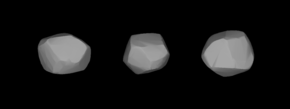Circe, minor planet designation 34 Circe, is a large, very dark main-belt asteroid. It was discovered by French astronomer J. Chacornac on April 6, 1855, and named after Circe, the bewitching queen of Aeaea island in Greek mythology.
 A three-dimensional model of 34 Circe based on its light curve | |
| Discovery | |
|---|---|
| Discovered by | J. Chacornac |
| Discovery date | April 6, 1855 |
| Designations | |
Designation | (34) Circe |
| Pronunciation | /ˈsɜːrsiː/[1] |
Named after | Circe |
| 1965 JL | |
| Main belt | |
| Adjectives | Circean /sərˈsiːən/[2] |
| Orbital characteristics[3] | |
| Epoch November 4, 2013 (JD 2456600.5) | |
| Aphelion | 2.967739 AU |
| Perihelion | 2.406230 AU |
| 2.686984 AU | |
| Eccentricity | 0.1045 |
| 4.40 a (1607.332 d) | |
Average orbital speed | 18.12 km/s |
| 39.80474° | |
| Inclination | 5.498° |
| 184.44157° | |
| 330.2330° | |
| Physical characteristics | |
| Dimensions | 113.02 ± 4.90 km[4] |
| Mass | (3.66 ± 0.03) × 1018 kg[4] |
Mean density | 4.83 ± 0.63 g/cm3[4] |
| ~0.0317 m/s² | |
| ~0.0600 km/s | |
| 0.5063 d (12.15 h) [3] | |
| Albedo | 0.0541 [3] |
| Temperature | ~172 K |
Spectral type | C |
| 8.51 | |
The spectrum of this object matches a C-type asteroid, suggesting a carbonaceous composition. It has a cross-section size of 113 km and is orbiting the Sun with a period of 4.40 years. Photometric observations of this asteroid made during 2007 at the Organ Mesa Observatory in Las Cruces, New Mexico gave an asymmetrical bimodal light curve with a period of 12.176 ± 0.002 hours and a brightness variation of 0.17 ± 0.02 in magnitude.[5] The spectra of the asteroid displays evidence of aqueous alteration.[6]
References edit
- ^ "Circe". Lexico UK English Dictionary. Oxford University Press. Archived from the original on 22 March 2020.
- ^ "Circean". Oxford English Dictionary (Online ed.). Oxford University Press. (Subscription or participating institution membership required.)
- ^ a b c Yeomans, Donald K., "34 Circe", JPL Small-Body Database Browser, NASA Jet Propulsion Laboratory, retrieved 21 December 2013.
- ^ a b c Carry, B. (December 2012), "Density of asteroids", Planetary and Space Science, 73 (1): 98–118, arXiv:1203.4336, Bibcode:2012P&SS...73...98C, doi:10.1016/j.pss.2012.03.009, S2CID 119226456. See Table 1.
- ^ Pilcher, Frederick (September 2008), "Period Determinations for 26 Proserpina, 34 Circe 74 Galatea, 143 Adria, 272 Antonia, 419 Aurelia, and 557 Violetta", The Minor Planet Bulletin, 35 (3): 135–138, Bibcode:2008MPBu...35..135P.
- ^ Fornasier, S.; et al. (February 1999), "Spectroscopic comparison of aqueous altered asteroids with CM2 carbonaceous chondrite meteorites", Astronomy and Astrophysics Supplement, 135: 65−73, Bibcode:1999A&AS..135...65F, doi:10.1051/aas:1999161.
External links edit
- 34 Circe at AstDyS-2, Asteroids—Dynamic Site
- 34 Circe at the JPL Small-Body Database